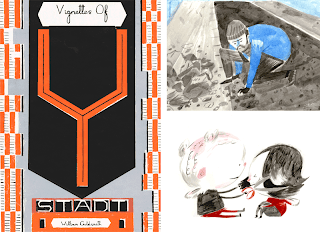Dan Matutina is one of my favourite illustrators at the moment; his work is a cool mix of digital and hand made elements, and often has a lovely filmic quality to it. He describes it himself as 'a mix of clean & dirty, modern & old', and this can be seen not just in the look of his work but also the content, which often involve imaginative stories and references to science fiction and myths.
Dan was kind enough to answer a few questions for me, and I've posted his answers below with a few examples of his work for you to get your peepers on. Cheers Dan!
1. How did you get into design/illustration?
I started illustrating and “designing” when I was small. I used to vandalize the wall of our house with my “artworks”. Haha. :) I did a bunch of illustrations and comics in grade school and high school. I formally learned how to design and illustrate when I took up Fine Arts in college.
2. Some of your work has a cinematic look about it, particularly your sci-fi related pieces, is film one of your inspirations? What else inspires you?
Yea, film has always been a big inspiration when I make illustrations. I try my best to make it cinematic. Film was my first love when I was in College (at the UP College of Fine Arts). My love for film started when my group got a film grant to produce a short film for our Electronic Media class. It was one of the most exciting experiences I had in my college life. I had my internship at the Film Institute where most of the Philippine independent film-makers came from. I was exposed to different films from different countries and it had a lasting effect on me.
3. Your works are often based around sci-fi / mythological stories or themes. Such themes are often a playground for the imagination, is this what draws you to them?
I’ve always loved science and science fiction back in high school. The high school I went to had a strong focus on science & technology. As for the interest in mythologies, it came from growing up in the province (an hour flight from the capital). In my childhood, my grandmother would share different folk stories and myths. I get the themes of my works from the stuff I liked in my childhood: sci-fi and myths.
4. Did you spend a lot of time developing your 'style'/ working method or did in come quite naturally to you? Is it how you've always worked?
The style just eventually came. I have contradicting tastes & likes, so discovering my style just happened when I was trying to balance these contradictions. Having said that, I think I can still push it a bit more.
5. Your work often includes really nice use of textures, marks, ink splatters etc., how much of this do you create digitally, and what draws you to the blend of natural and digital?
Most of the textures, brush strokes & spatters are hand made. I scan and apply them on the digital illustrations I make. I like the crisp, clean look of digital illustrations and hand painted water illustrations. So I thought, why not combine them?
6. How do you go about coming up with ideas for briefs/projects? How do you get through a creative block? (if you get them!)
Most the ideas for my personal works come from experience. It’s always fun to get ideas from experience because they can be very unique. For client works I research the topics first and then think of different ways to answer the brief. Yea, getting a creative block is part of every creative person’s life. When it hits me, I try to relax, drink coffee, read a book, surf the net, play video games or travel.
7. When creating an illustration do you work on your own or in a studio with others? Do you think it helps your creativity to be around like minded designers/students?
It depends. Sometimes I love working by my lonesome & sometimes it’s great to be with other people. Yea, it’s a big help to be with other creative friends. You can consult ideas, ask for their honest opinion and share stories. There are times when it’s better to work on your own. This particularly happens when I think about initial ideas for a new project.
8. Finally, what advice would you give to aspiring designers or illustrators?
Take risks! Take risks with your design and career decisions. When things become too comfortable it means there’s something wrong. Use the internet to your advantage. Share your ideas with other people & collaborate with them. Be open to criticisms because you can only improve from them. And more importantly, have fun. :D
><><><><><><><><><><






























